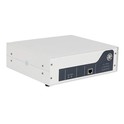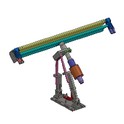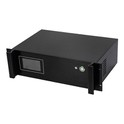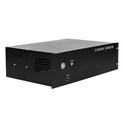As a supplier of universal ultrasonic generators, I've witnessed firsthand the numerous applications and advantages these devices offer across various industries. However, like any complex equipment, they are not immune to problems. In this blog post, I'll discuss some common issues with universal ultrasonic generators and provide practical solutions.
Overheating
One of the most prevalent problems with universal ultrasonic generators is overheating. This can occur due to several reasons, including continuous operation at high power levels, poor ventilation, or a malfunctioning cooling system. When an ultrasonic generator overheats, it can lead to reduced performance, component damage, and even system failure.
Solution:
- Optimize Operating Conditions: Avoid running the generator at maximum power for extended periods. If possible, alternate between high and low power settings or take short breaks during continuous operation.
- Improve Ventilation: Ensure that the generator is installed in a well - ventilated area. Remove any obstructions around the ventilation ports and consider using additional fans or ventilation systems if necessary.
- Check the Cooling System: Regularly inspect the cooling system, including the radiator, fans, and coolant levels. Replace any damaged components and refill the coolant as needed.
Frequency Drift
Frequency drift is another common issue where the output frequency of the ultrasonic generator deviates from the set value. This can affect the efficiency of the ultrasonic process and may lead to inconsistent results. Frequency drift can be caused by factors such as component aging, temperature changes, or electrical interference.
Solution:
- Use High - Quality Components: Select ultrasonic generators that are built with high - quality components that are less prone to frequency drift. Our 1000W Ultrasonic Generator and 2000W Ultrasonic Generator are designed with precision components to minimize frequency drift.
- Stabilize the Environment: Keep the operating environment of the generator as stable as possible. Control the temperature and humidity levels, and shield the generator from electrical interference sources such as motors or power lines.
- Calibrate Regularly: Periodically calibrate the ultrasonic generator to ensure that the output frequency remains within the desired range. Follow the manufacturer's calibration procedures or seek professional calibration services.
Power Output Instability
Power output instability can manifest as fluctuations in the ultrasonic power, which can lead to inconsistent cleaning, welding, or other ultrasonic processes. This problem can be caused by issues with the power supply, faulty components in the generator, or improper load matching.
Solution:
- Verify the Power Supply: Check the power supply to ensure that it is stable and within the specified voltage and frequency range. Use a voltage regulator if necessary to protect the generator from power surges or fluctuations.
- Inspect Components: Regularly inspect the internal components of the generator for signs of damage or wear. Replace any faulty components such as capacitors, resistors, or transistors.
- Match the Load Correctly: Ensure that the ultrasonic transducer is properly matched to the generator. An improper load can cause power reflections and instability. Consult the manufacturer's guidelines for load matching requirements.
Poor Signal Transmission
In some cases, the ultrasonic generator may experience poor signal transmission to the transducer. This can result in weak or ineffective ultrasonic waves, leading to sub - optimal performance. Poor signal transmission can be caused by damaged cables, loose connections, or problems with the transducer itself.
Solution:
- Check the Cables: Inspect the cables connecting the generator to the transducer for any signs of damage, such as cuts, frays, or corrosion. Replace any damaged cables with high - quality ones.
- Tighten the Connections: Make sure that all connections between the generator, cables, and transducer are tight and secure. Loose connections can cause signal loss or interference.
- Test the Transducer: If the problem persists, test the transducer to ensure that it is functioning properly. Replace the transducer if it is found to be defective.
Alarm Activation
Most universal ultrasonic generators are equipped with alarm systems to indicate potential problems. Alarm activation can be triggered by various issues such as overheating, over - current, or low power. Ignoring these alarms can lead to serious damage to the generator.
Solution:
- Read the Alarm Codes: Familiarize yourself with the alarm codes of the ultrasonic generator. Refer to the user manual to understand the meaning of each alarm code and the recommended actions.
- Investigate the Cause: When an alarm is activated, immediately stop the operation of the generator and investigate the cause. Check the relevant parameters such as temperature, current, and power to identify the problem.
- Resolve the Issue: Once the cause of the alarm is identified, take the necessary steps to resolve the issue. This may involve adjusting the settings, replacing components, or seeking technical support.
No Output or Low Output
If the ultrasonic generator produces no output or a very low output, it can be a frustrating problem. This can be caused by a variety of factors, including power supply issues, component failures, or programming errors.
Solution:
- Check the Power Supply: Ensure that the generator is properly connected to the power supply and that the power switch is turned on. Measure the input voltage to confirm that it is within the correct range.
- Inspect the Fuses: Check the fuses in the generator for signs of blowing. Replace any blown fuses with the correct rating.
- Review the Programming: Double - check the programming settings of the generator. Make sure that the output power, frequency, and other parameters are set correctly. If necessary, reset the generator to its default settings and reprogram it.
Noise and Vibration
Excessive noise and vibration from the ultrasonic generator can be a nuisance and may also indicate underlying problems. Noise and vibration can be caused by loose components, unbalanced rotating parts, or improper installation.


Solution:
- Tighten Loose Components: Inspect the generator for any loose components and tighten them as needed. This includes screws, bolts, and nuts.
- Balance the Rotating Parts: If the generator has rotating parts such as fans or motors, ensure that they are properly balanced. Unbalanced parts can cause excessive vibration and noise.
- Improve the Installation: Make sure that the generator is installed on a stable and level surface. Use vibration - isolating pads or mounts to reduce the transmission of vibration to the surrounding environment.
Compatibility Issues
When integrating the ultrasonic generator with other equipment or systems, compatibility issues may arise. These issues can include electrical interference, communication problems, or differences in operating parameters.
Solution:
- Consult the Manufacturer: Before integrating the ultrasonic generator with other equipment, consult the manufacturer for compatibility information. They can provide guidance on how to ensure seamless integration.
- Use Isolation Devices: If there is electrical interference between the generator and other equipment, use isolation devices such as transformers or filters to protect the equipment from interference.
- Standardize the Parameters: Ensure that the operating parameters of the generator and other equipment are compatible. Adjust the settings as necessary to achieve optimal performance.
In conclusion, while universal ultrasonic generators offer many benefits, they can encounter various problems. By being aware of these common issues and implementing the appropriate solutions, you can ensure the reliable and efficient operation of your ultrasonic generator. As a trusted supplier of universal ultrasonic generators, we are committed to providing high - quality products and excellent technical support. If you are experiencing any problems with your ultrasonic generator or are looking to purchase a new one, such as our 4000W Ultrasonic Generator, please feel free to contact us for procurement and technical consultation.
References
- Ultrasonic Generator User Manuals
- Industry - specific Ultrasonic Application Guides
- Technical Papers on Ultrasonic Technology






